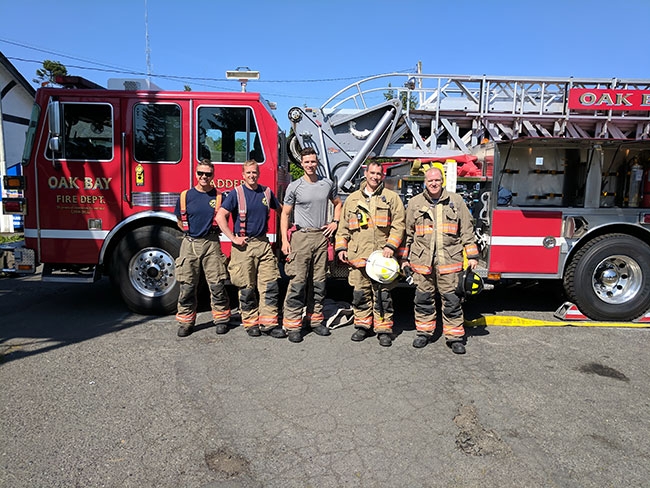
Features
Health and wellness
Hot topics
Supporting and Sustaining
You have established a health and wellness program in your department. Now what? How do you ensure its viability over the long term? How do you continue to support your firefighters in maintaining their overall health and wellbeing? These important questions shift focus towards the long-term vision, goals, and sustainability of the program, including budget considerations.
July 16, 2018
By Fire Chief Dave Cockle and Sara Wegwitz Registered Nurse
 Firefighters and team members from the Oak Bay fire department posing in front of their truck. In the final installment of a five-part series looking at Oak Bay fire
Department’s holistic health and wellness program
Firefighters and team members from the Oak Bay fire department posing in front of their truck. In the final installment of a five-part series looking at Oak Bay fire
Department’s holistic health and wellness programThe fire department, through the municipality or regional district, should be committed to enhancing the health, productivity, and quality of life for firefighters and first responders. This level of commitment to invest in our people will assist with the maintenance of the health and wellness program (and with the development of a cutting-edge program). We recognize and acknowledge that the challenges presented to our firefighters are complex and demand that we be open to creative strategies to meet our goal of building a sustainable program.
Business management in the fire department is based upon regulations, standards, council strategic priorities and people. Government agencies continually manage competing priorities and funding to support our programs within our departments. We know that through a well-managed holistic health and wellness program, our firefighters are physically, mentally, and spiritually healthy and thus more productive. Healthy, productive employees are essential to success in all organizations and especially in protective services where the physical and mental demands are so high.
Your health and wellness program should be managed strategically as a core value of your organization and included in the overall strategic planning for your department. To be truly sustainable we must not manage the well-being of our responders solely for risk management; rather our program should be rooted in the core of what we do as firefighters and as an organization. Understanding how our people eat, move, think, and sleep enables leaders to create program that fashions an organization in which employees are valued, recognized by cultural differences, and supported in developing and maintaining healthy choices and lifestyles. Challenge yourself and the health and wellness committee to change the department culture and embrace the correlation of employee well-being with productivity achieved through a properly managed wellness program.
Your program should be subject to the same sustainability test as any other goals and objectives of the department. Sustainability of the health and wellness program begins with good governance by having some terms of reference in place and using a committee model that provides for input to the process for planning and implementation. Sustainable programs are not managed from the side of the desk. Doing so will doom them to failure. Good terms of reference will go a long way to building the relationships and supporting the actions of the committee in making change.
The program will face challenges when it comes to implementing and sustaining your program. To alleviate some of the negativity we meet as a committee on a regular basis to address those concerns and build on the opportunities that are presented. The department has a health and wellness team leader on each crew who has the responsibility to manage the health and wellness objectives on that crew. They are also responsible for bringing forward the concerns of, and suggestions from, the crew to enhance the program. The team leader is normally the junior member of the department which helps to build the team aspect of the crews. There are two exempt fire department staff on the committee representing management who work collaboratively with the members to adapt and shape the program.
To be successful, our health and wellness team takes a solutions-based approach to setting goals and objectives. Here are some basic principles to guide the planning for a sustainable wellness program and workplace strategy that have worked for us.
Determine realistic outcomes, long-term and short-term goals, where to start, and what to focus on. These are key principles for our program’s long-term sustainability. It’s not realistic to have a team of Olympic athletes over a 30-year career in the fire service, but it is achievable to have a culture of healthy habits and lifestyle choices accountable by the employer and employees. We started with a plan that included a briefing to council for funding to support the project including an annual reporting structure on achievements and challenges. We developed a two-year plan to start, reviewed annually, and we use baseline testing to understand current health and fitness levels of our responders. Our goal was to create a holistic approach to firefighter well-being and improve their quality of life throughout their career.
Program scheduling must be flexible enough to address the shift pattern and daily schedule of the responders. This is an area of significance with our department and speaks to changing the culture of the department. We are five years in and we are continuing to maintain the “buy-in” for the program by our management staff and members by addressing scheduling. The department had a regimented daily schedule that had been in place for 50 years. Labour and management agreed to go away from that schedule to allow for health and wellness time while still ensuring that the daily routine was completed. Your team will need to be flexible. Be realistic with the time commitment of the department and ensure that members understand that there will be days that allow for health and wellness and days, due to work commitments, that do not. Finding a balance in your department schedule to ensure time is allocated is paramount to a successful program. Limit the barriers to providing the allotted time in your work schedule for health and wellness. There are only positives in this step by recognizing what the priorities are for the day and focusing on creating opportunities for success as an organization with your program.
The program must be inclusive of all your employee groups. The program will be challenged if only the suppression divisions are participating. Supervisors and officers need to be committed to building employee engagement through practical ideas. One positive of creating a culture of wellness is building strength in your team. In our department every staff member, firefighter or not, is included in the health and wellness plan and is encouraged to participate. Sustainability is about being inclusive and adaptable.
Funding support must match the goals of the program. An underfunded program with unrealistic goals is unsustainable. It is imperative to have good analytics and reporting of your health and wellness program. From a financial position the program must be subject to the same sustainability test as the other goals and objectives of the department. Wellness opportunities are also good news stories. Take the opportunity to promote your program through your local reporter and your social media outlets. Share your findings within the organization to other departments and externally with business organizations. Councils support projects that put them in a positive light and that they can rally behind. If you provide them the benefits versus the risk for the cost of your program, it will sell itself. Councils also support cutting-edge projects with minimal downsides.
Create a work environment that supports holistic, healthy living. Make business decisions that support the goals and objectives of your health and wellness program fostering support throughout the department. Embrace creative strategies that speak to the culture of the organization in improving health and well-being. The benefits will include reduced sick time and a positive work environment.
Account for and report on results, meet outcome targets aligned with budget and ensure accountability at all levels of the organization for the program. By documenting and reporting results you can continue to develop and adapt the health and wellness program to meet your goals and objectives. Good documentation provides accountability to the program creating opportunities for review and growth.
Our firefighters and support staff are our greatest assets we must ensure operational readiness when the bells ring. Creating a sustainable health and wellness program to support them will benefit the members and the community. A sustainable health and wellness program starts with leadership taking the first steps to change the department culture and provide the key tools to our responders, so they can thrive and survive in the fire service.
Chief Dave Cockle has been a career firefighter with the Oak Bay Fire Department for 30 years. Contact him at dcockle@oakbay.ca. Sara Wegwitz is a registered nurse who specializes in mental fitness and resilience training. She is the primary facilitator of the Oak Bay Fire Department’s wellness program. Contact her at sara@tailormakinghealth.ca.
Print this page

